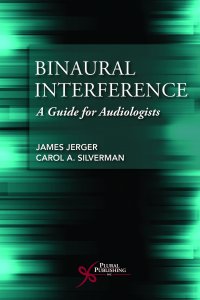Binaural Interference- A Guide for Audiologists
By James Jerger and Carol Silverman, Plural Publishing, Inc., 2018. 124 pages. ISBN# 978-1-63550-076-9.
ISBN: 978-1-63550-076-9
List price: $69.95
URL: http://pluralpublishing.com/publication_biga.htm
 As the editor in chief of Canadian Audiologist it is my responsibility to select reviewers for new publications. Typically this can be like pulling teeth but for Binaural Interference- A Guide for Audiologists there was a deluge of volunteer reviewers. I first thought of playing King Solomon who threatened to divide a baby in biblical times by cutting up the book and sending a bit to each of the reviewers, but I decided to keep the book to myself to review.
As the editor in chief of Canadian Audiologist it is my responsibility to select reviewers for new publications. Typically this can be like pulling teeth but for Binaural Interference- A Guide for Audiologists there was a deluge of volunteer reviewers. I first thought of playing King Solomon who threatened to divide a baby in biblical times by cutting up the book and sending a bit to each of the reviewers, but I decided to keep the book to myself to review.
Binaural interference has been described in the literature as early as 1939 and refers to the fact that, in some individuals, speech entering one ear interferes with the same speech coming into the other ear. This has ramifications for hearing aids, where two hearing aids may not result in a binaural fitting.
This short 124-page book has 7 chapters, each of which is concise and well-written. In some other hands this book undoubtedly would have been needlessly longer, but Doctors Jerger and Silverman get directly to the point. Having said this, the book is very easy to read and the literature review proceeds as a very logical story line. Each chapter ends with a summary.
Chapters 1–3 provide a history of the discovery that perhaps the brain cannot always properly synthesize the information from the two ears. There is a clear discussion of the direct and the indirect evidence of binaural interference with a review of the possible causes. This may in part be related to cochlear sensory asymmetries or asymmetrical function in the neural processing between the two ears, including the role of the corpus callosum. Chapter 4 provides some illustrative examples of binaural interference for people with age-related sensori-neural hearing loss and with neural involvement.
Chapter 5 deals with the clinical evaluation of binaural interference and chapter 6 deals with future directions touching on some possible methods to begin assessing this.
The final chapter (7) has the title of Lessons Learned. It provides a clinically relevant summary of what the audiologist needs to know to assess, and be on the look-out, for the possibility of binaural interference with their clients.
This book, which I highly recommend, dovetails nicely with another book by Dr. Jerger- James Jerger: A Life in Audiology (Plural Publishing, Inc.). This is a delightful book about Dr. Jerger’s professional life where there are frequent hints about his long-standing interest in binaural interference.

